You can dramatically improve your sleep recovery by using smartwatch analysis to track your sleep stages, heart rate variability, and movement patterns throughout the night. The Oura Ring Gen 3 offers the highest accuracy at 79.5% sensitivity for deep sleep detection, while devices like Apple Watch and Fitbit provide valuable insights despite some limitations. Smart alarms wake you during light sleep phases, reducing grogginess, while recovery scores help you adjust daily activities based on your body’s restoration needs for peak performance.
Understanding Sleep Stage Detection Accuracy Across Leading Devices
How accurately can your smartwatch detect different sleep stages compared to clinical-grade equipment?
The Oura Ring Gen 3 leads with 76.0-79.5% sensitivity, making it most comparable to polysomnography (PSG) results. Your Fitbit Sense 2 offers moderate accuracy at 61.7-78.0%, while the Apple Watch Series 8 shows wider variation from 50.5-86.1%.
The Oura Ring Gen 3 demonstrates superior sleep tracking accuracy compared to Fitbit and Apple Watch across clinical studies.
All devices excel at detecting sleep versus wakefulness with ≥95% sensitivity.
However, each device has specific limitations. Your Fitbit tends to overestimate light sleep and underestimate deep sleep.
Apple Watch often inaccurately estimates deep sleep and wakefulness. The Oura Ring maintains the most consistent results across different sleep stages, though it may struggle with extremely variant sleep patterns. Most devices still struggle with wakeup detection despite their advances in overall sleep tracking capabilities.
Leveraging Smartwatch Data to Optimize Recovery Patterns
Your smartwatch doesn’t just track sleep stages—it transforms that data into actionable recovery insights that can revolutionize your rest patterns.
By analyzing your sleep stage shifts, recovery metrics, and individual patterns, you’ll discover when your body truly recovers and how to maximize those vital restorative periods. This comprehensive monitoring utilizes heart rate variations during different sleep stages to provide deeper insights into your recovery quality.
This personalized approach lets you move beyond generic sleep advice and create recovery strategies tailored specifically to your body’s unique rhythms.
Sleep Stage Analysis
Modern smartwatches transform your wrist into a sophisticated sleep laboratory, using accelerometers and heart rate monitors to decode the intricate cycles of your nightly rest. These devices differentiate between wakefulness, light sleep, deep sleep, and REM stages by analyzing movement patterns and heart rate variability.
| Sleep Stage | Key Indicators |
|---|---|
| Light Sleep (N1/N2) | Minimal movement, stable heart rate |
| Deep Sleep (N3) | Very little movement, lowest heart rate |
| REM Sleep | Variable heart rate, minimal body movement |
| Wakefulness | Increased movement, elevated heart rate |
Machine learning algorithms continuously adapt to your unique sleep patterns, improving accuracy over time. Your smartwatch’s pattern recognition capabilities filter noise and identify sleep interruptions, providing personalized insights that help optimize your recovery cycles for better overall sleep quality. Advanced models incorporate ambient light sensors to monitor environmental light levels, enhancing the precision of sleep and wake time detection.
Recovery Metrics Tracking
Beyond simply tracking sleep stages, smartwatches excel at measuring recovery through thorough physiological monitoring that reveals how well your body’s bouncing back from daily stressors.
These devices continuously analyze multiple metrics to provide extensive recovery insights that help you optimize your rest and performance.
Your smartwatch tracks several key recovery indicators:
- Heart Rate Variability (HRV) – Higher variability indicates better stress resilience and recovery status
- Respiratory Rate Analysis – Monitors breathing patterns during rest to assess stress levels
- Skin Temperature Changes – Detects fluctuations that reflect recovery and stress responses
- Movement Patterns – Analyzes restlessness during sleep to gauge recovery quality
Through AI-driven analysis and machine learning algorithms, your device combines this data to generate recovery scores and personalized recommendations, enabling you to make informed adjustments to your sleep schedule and recovery strategies. Professional reviewers typically spend weeks to months testing these devices in real-world scenarios to evaluate how accurately they measure recovery metrics during performance-intensive activities and daily use.
Personalized Pattern Insights
While generic sleep recommendations offer broad guidance, smartwatches transform recovery optimization by establishing your unique baseline patterns and detecting meaningful deviations that signal when your body needs attention.
Your device’s algorithms learn your specific sleep norms, then flag variations in REM duration or deep sleep percentage that indicate suboptimal recovery.
Context-aware insights correlate these patterns with your daily activities, stress levels, and environmental factors. When you experience reduced deep sleep after intense training, your smartwatch provides tailored feedback suggesting recovery adjustments. The device monitors your complete sleep cycle duration of 90 to 110 minutes to identify when REM phases lengthen throughout the night.
This dynamic adaptation evolves with your lifestyle changes, ensuring recommendations remain relevant.
Studies confirm these personalized insights accurately quantify sleep patterns, enabling data-driven modifications to enhance your recovery strategies through targeted sleep improvements.
Comparing Oura Ring, Apple Watch, and Fitbit Performance Metrics
When you’re choosing between popular sleep tracking devices, understanding their actual performance against clinical standards reveals significant differences in accuracy and reliability.
The Oura Ring Gen 3 consistently outperforms both Apple Watch Series 8 and Fitbit Sense 2 across critical metrics.
Here’s how these devices compare against polysomnography standards:
- Deep Sleep Detection: Oura achieves 79.5% sensitivity versus Fitbit’s 61.7% and Apple’s 50.5%
- Stage Accuracy: Oura shows no significant over/underestimation while Apple overestimates light sleep by 45 minutes
- Overall Precision: Oura maintains 77-79.5% precision across all sleep stages consistently
- Battery Performance: Oura’s multi-day battery life guarantees uninterrupted monitoring unlike daily charging requirements
You’ll find Oura’s ring form factor and superior accuracy make it the most reliable choice for serious sleep recovery tracking. The scientific validation provided by studies at Brigham and Women’s Hospital demonstrates the importance of peer-reviewed research in evaluating wearable device effectiveness.
Advanced Sleep Tracking Features That Enhance Recovery Analysis
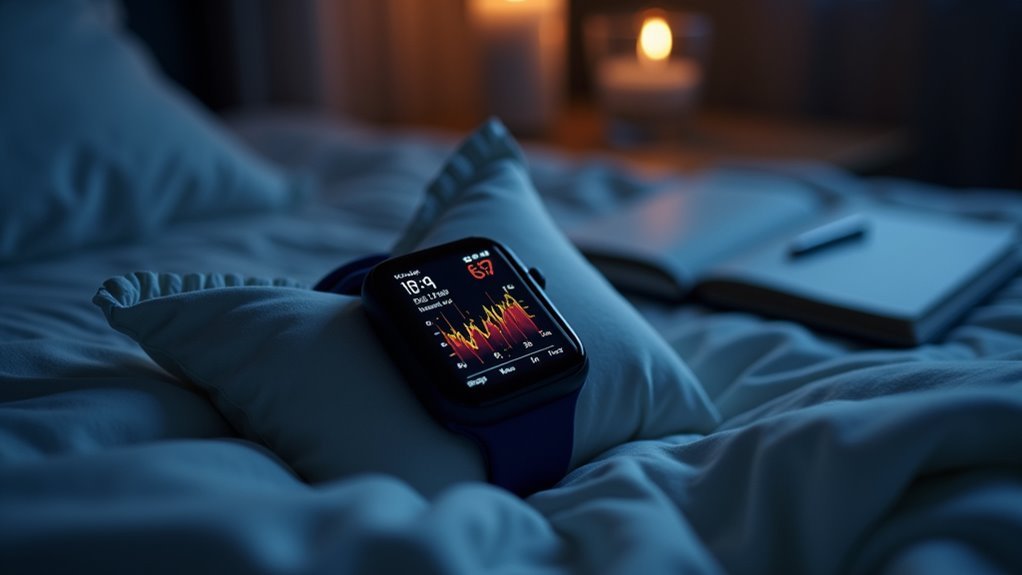
You’ll find that modern smartwatches excel at breaking down your sleep into distinct stages like REM, deep, and light sleep, giving you precise insights into recovery quality.
These devices integrate smart alarm technology that wakes you during lighter sleep phases, helping you feel more refreshed and recovered.
Advanced sensors continuously monitor your heart rate variability, respiratory patterns, and blood oxygen levels throughout the night, creating a thorough picture of how well your body’s actually recovering. For optimal data collection, you should wear your watch for at least two hours before bedtime to ensure the most accurate sleep analysis and recovery metrics.
Multi-Stage Sleep Classification
As smartwatch technology advances beyond simple step counting, multi-stage sleep classification transforms your wrist-worn device into a sophisticated sleep laboratory. Your smartwatch now analyzes raw sensor signals from accelerometers and heart rate monitors, converting time-series data into detailed sleep stage patterns.
Through machine learning algorithms like SVMs and deep learning models, your device can distinguish between multiple sleep phases with remarkable precision.
The multi-stage classification process involves:
- Multi-class classification – Categorizing sleep into wake, light, deep, and REM stages
- NREM/REM separation – Advanced sleep cycle analysis for recovery optimization
- Leveled correction – Two-classifier systems that detect and reclassify initial errors
- PSG validation – Benchmarking against clinical polysomnography standards
This sophisticated approach achieves up to 84% accuracy in two-stage classification, enabling extensive sleep recovery tracking. Modern systems utilize visual representations such as spectrograms and recurrence plots to transform raw sensor data into image-like formats that enhance pattern recognition capabilities.
Smart Alarm Integration
Why settle for jarring alarms that rip you from deep sleep when your smartwatch can orchestrate gentle, recovery-enhanced wake-ups?
Smart alarm integration analyzes your real-time sleep data to trigger alarms during light sleep phases near your desired wake time, dramatically reducing morning grogginess and improving alertness.
Your smartwatch continuously monitors heart rate and movement, calculating recovery scores based on sleep quality and duration.
You’ll receive AI-driven recommendations aligned with your natural circadian rhythm for superior recovery outcomes. Wake-up windows can be customized to span 10 to 45 minutes, allowing your device to find the optimal moment within your preferred timeframe.
Setup’s effortless—enable smart alarms through simple taps or voice commands, with watch face complications clearly indicating alarm status.
Advanced features include sunrise simulation with smart bulbs, snore detection linking nighttime disturbances to recovery data, and automated sleep diary logging for thorough recovery assessment.
Advanced Sensor Technology
Beyond basic sleep duration tracking, today’s smartwatches pack sophisticated sensor arrays that transform your wrist into an all-encompassing recovery analysis center.
These advanced devices continuously monitor multiple physiological markers throughout your sleep cycle, delivering insights that were once available only in sleep laboratories.
Modern smartwatches leverage cutting-edge sensors to provide extensive recovery data:
- Heart Rate Variability Monitoring – Tracks your autonomic nervous system’s recovery state through continuous heart rate analysis
- Multi-Stage Sleep Detection – Identifies light, deep, and REM phases to optimize your recovery timing
- Skin Temperature Analysis – Monitors thermal fluctuations that indicate sleep quality and potential health anomalies
- Advanced Movement Tracking – Detects micro-movements and restlessness patterns affecting recovery quality
This sensor integration enables precise recovery assessment beyond traditional sleep tracking methods. The market now offers diverse form factors including smart rings, fitness trackers, and even headband-style devices to accommodate different user preferences and comfort levels.
Interpreting Sleep Efficiency Data for Athletic Performance
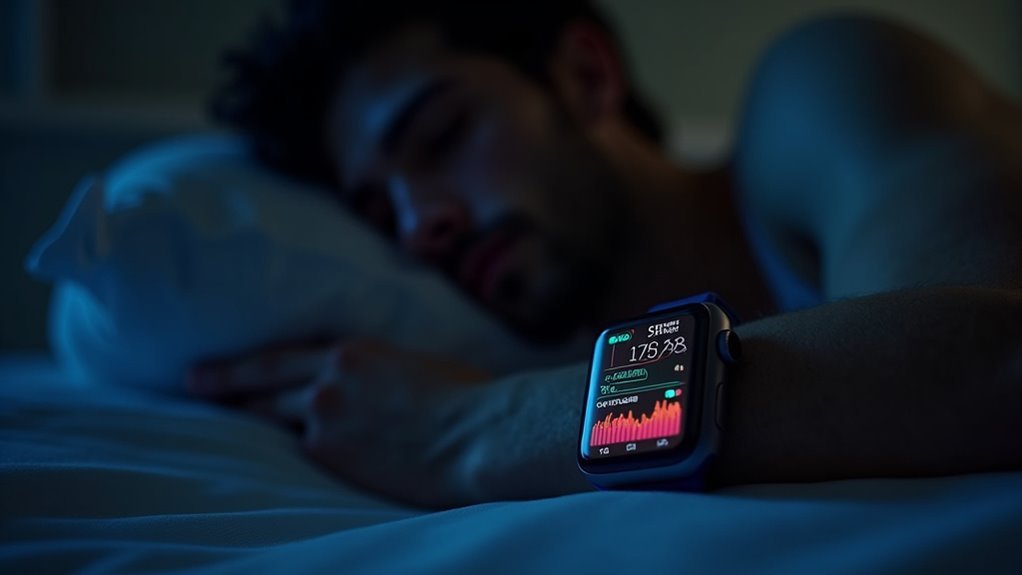
How effectively are you sleeping during your time in bed? Sleep efficiency measures the percentage of time you’re actually asleep versus lying awake, and your smartwatch captures this vital metric.
If you’re an athlete, you’re likely experiencing lower sleep efficiency at around 80.6% compared to non-athletes who achieve higher rates.
Poor sleep efficiency directly impacts your muscular strength, speed, and overall performance. When you’re tossing and turning, you’re increasing your injury risk and hampering recovery.
Your smartwatch data reveals these patterns, showing restless periods and wake episodes throughout the night. Elite athletes commonly experience habitual short sleep of around 7 hours per night, which compounds efficiency problems.
You can improve your efficiency by establishing consistent sleep schedules and creating a sleep-conducive environment.
Monitor your smartwatch trends weekly to identify improvements and track how better efficiency correlates with enhanced performance metrics.
Behavioral Modifications Based on Smartwatch Sleep Insights
When your smartwatch reveals you’re spending excessive time in light sleep stages, it’s signaling the need for immediate behavioral adjustments to optimize your recovery.
Your device’s thorough data collection through G-sensors and heart rate monitors provides actionable insights that can transform your sleep quality.
Based on your smartwatch’s sleep stage detection capabilities, you can implement these targeted modifications:
- Adjust your bedtime routine by establishing consistent sleep schedules when data shows irregular patterns.
- Modify your daily activities based on recovery insights to enhance deep sleep duration.
- Track REM sleep disorders early, especially if you’re at risk for conditions like Parkinson’s disease.
- Integrate sleep data with other health metrics for thorough lifestyle changes.
Your psychological motivation increases when you understand these patterns, leading to sustained engagement in sleep improvement behaviors. The continuous data collection enables comprehensive assessment of your sleep behavior patterns over extended periods for more accurate intervention outcomes.
Maximizing Recovery Through Sleep-Wake Cycle Monitoring
Your smartwatch’s sleep-wake cycle monitoring capabilities extend far beyond basic sleep stage tracking to provide thorough recovery enhancement through circadian rhythm analysis.
By continuously tracking physiological markers like heart rate, breathing patterns, and movement, your device identifies when you’re truly aligned with your natural circadian rhythm. This alignment directly impacts hormone release, body temperature regulation, and metabolic health—all vital for effective recovery.
When your smartwatch detects consistent sleep-wake patterns, it can predict your ideal recovery windows and readiness for physical activity.
The longitudinal data reveals correlations between disrupted sleep cycles and delayed muscle repair or compromised immune function. Since algorithm transparency varies significantly between devices, understanding your specific smartwatch’s data processing methods becomes crucial for accurate recovery assessment. You’ll receive actionable insights about maintaining regular sleep schedules, which research shows can considerably shorten recovery time and enhance both physical restoration and cognitive performance.
Frequently Asked Questions
How Long Should I Wear a Smartwatch Before Getting Reliable Sleep Data?
You’ll need at least two weeks of consistent nightly wear to establish basic sleep patterns, but you’ll get more reliable data after 4-6 weeks as algorithms adapt to your habits.
Can Smartwatch Sleep Tracking Work Effectively for Shift Workers or Irregular Schedules?
Smartwatch sleep tracking can work for shift workers, but you’ll experience reduced accuracy during irregular schedules. The devices struggle with disrupted sleep patterns, though apps like SleepSync help provide personalized scheduling recommendations.
Do Smartwatches Affect Sleep Quality or Comfort While Wearing Them Overnight?
You’ll generally find smartwatches comfortable for overnight wear, though some users experience minor discomfort. The device itself doesn’t greatly impact your sleep quality—your room’s temperature and noise levels affect sleep more than the watch.
What’s the Typical Battery Life Impact When Using Continuous Sleep Tracking Features?
You’ll typically see about 15% battery drain per night when using continuous sleep tracking. Heart rate and blood oxygen monitoring increase this drain considerably, though you can reduce impact by adjusting sensor settings.
Are There Privacy Concerns With Storing Personal Sleep Data on Smartwatch Apps?
Yes, you’re storing sensitive health data that’s vulnerable to breaches, unauthorized access, and third-party sharing. Your sleep patterns can reveal personal routines, locations, and health status, creating privacy risks.
In Summary
You’ll transform your recovery by leveraging smartwatch sleep data effectively. Start tracking your sleep stages consistently, then analyze patterns to identify what’s impacting your rest quality. Don’t just collect data—act on it by adjusting your bedtime routine, environment, and daily habits based on your device’s insights. You’ll see measurable improvements in sleep efficiency and athletic performance when you consistently apply these evidence-based modifications to optimize your sleep-wake cycles.

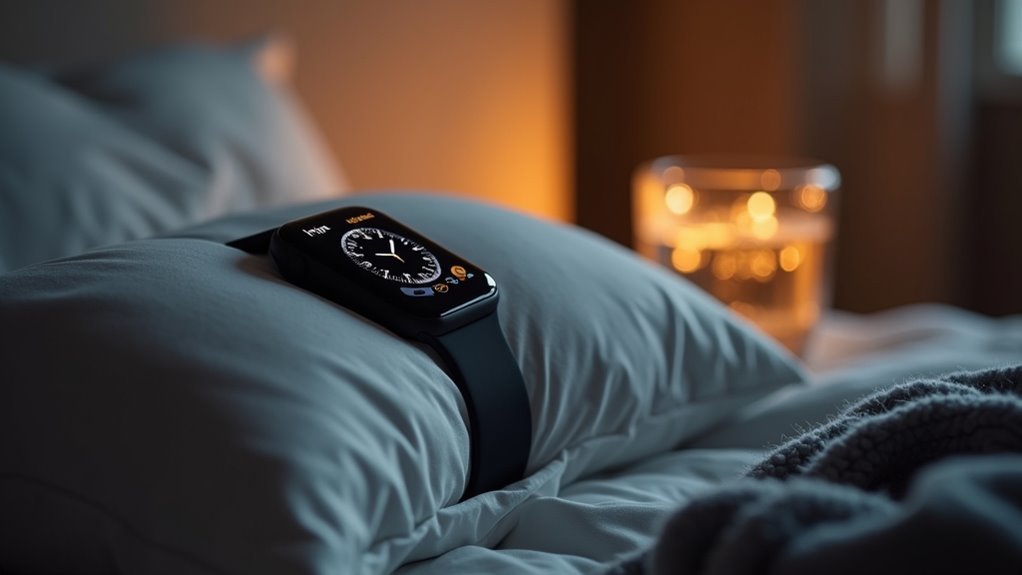
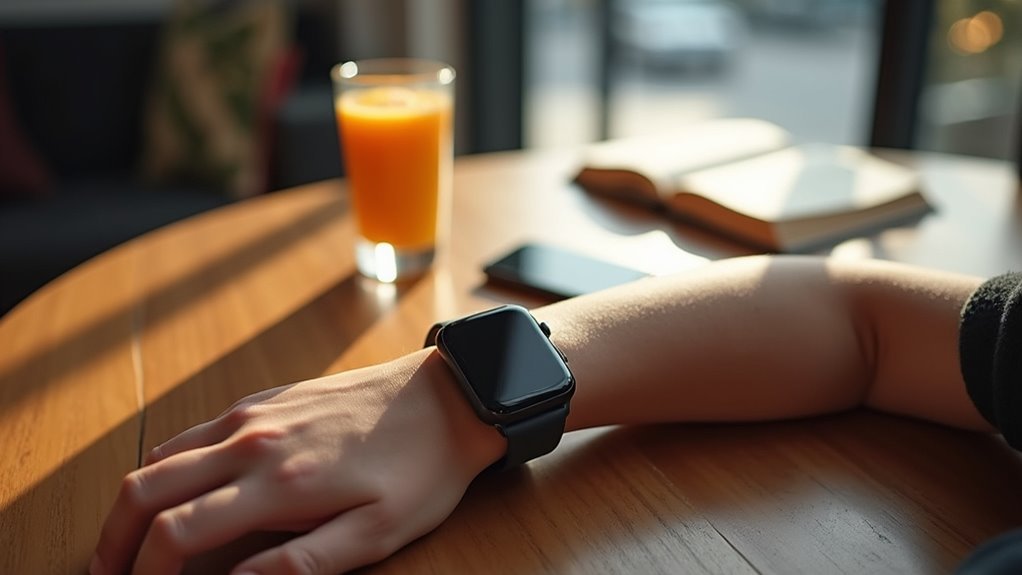
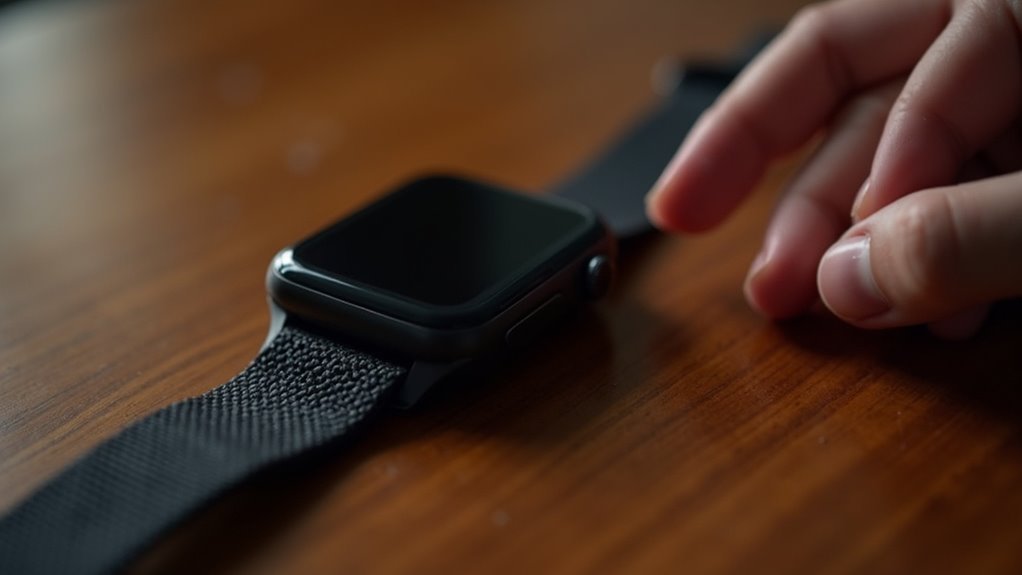

Leave a Reply